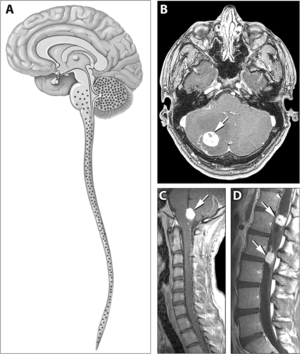Von Hippel-Lindau disease
| Von Hippel–Lindau disease | |
|---|---|
 |
|
| Typical distribution of hemangioblastomas in von Hippel–Lindau disease. | |
| Classification and external resources | |
| Specialty | medical genetics |
| ICD-10 | Q85.8 |
| ICD-9-CM | 759.6 |
| OMIM | 193300 |
| DiseasesDB | 14000 |
| eMedicine | ped/2417 oph/354 |
| Patient UK | Von Hippel–Lindau disease |
| MeSH | C10.562.400 |
| GeneReviews | |
| Orphanet | 892 |
Von Hippel–Lindau disease (VHL) is a disease which results from a mutation in the von Hippel–Lindau tumor suppressor gene on chromosome 3p25.3.
VHL disease can be subdivided according to the clinical manifestations, although these groups often correlate with certain types of mutations present in the VHL gene.
Signs and symptoms associated with VHL disease include headaches, problems with balance and walking, dizziness, weakness of the limbs, vision problems, and high blood pressure. Conditions associated with VHL disease include angiomatosis, hemangioblastomas, pheochromocytoma, renal cell carcinoma, pancreatic cysts (pancreatic serous cystadenoma), endolymphatic sac tumor, and bilateral papillary cystadenomas of the epididymis (men) or broad ligament of the uterus (women). Angiomatosis occurs in 37.2% of patients presenting with VHL disease and usually occurs in the retina. As a result, loss of vision is very common. However, other organs can be affected: strokes, heart attacks, and cardiovascular disease are common additional symptoms. Approximately 40% of VHL disease presents with CNS hemangioblastomas and they are present in around 60-80%. Spinal hemangioblastomas are found in 13-59% of VHL disease and are specific because 80% are found in VHL disease. Although all of these tumours are common in VHL disease, around half of cases present with only one tumour type.
The disease is caused by mutations of the von Hippel–Lindau tumor suppressor (VHL) gene on the short arm of chromosome 3 (3p25-26). There are over 1500 germline mutations and somatic mutations found in VHL disease.
...
Wikipedia
